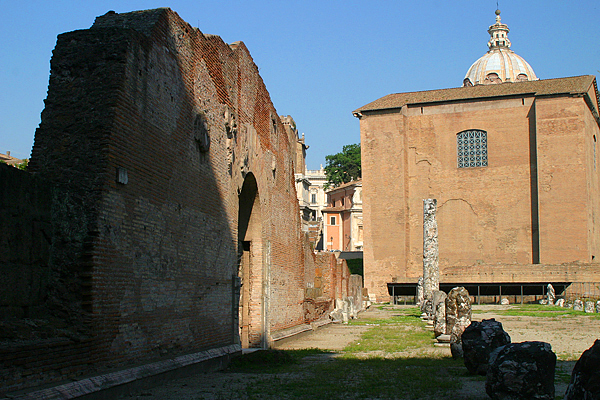

Erected in 179 BC by the censors Marcus Aemilius Lepidus (after whom the basilica is named) and Marcus Fulvius Nobilior, completely rebuilt over two decades and dedicated in 34 BC, restored after a fire by Augustus in 14 BC, and then again in AD 22 on its two-hundredth anniversary, the Basilica Aemilia was considered by Pliny to be one of the most beautiful buildings in Rome. It was a place for business and, in the porticus of Gaius and Lucius (the grandsons of Augustus) fronting the Forum, there were the Tabernae Novae (New Shops). On the colored marble floor one still can see the the stains of bronze coins.
This detail depicts Tarpea, who opened the city gates to the Sabines in exchange for what was on their arms, not realizing it would be their shields, under which she was buried for her treachery. It is a copy of the relief that adorned the architrave of the long central aisle of the basilica.
Ten years earlier, as consul, Nobilior had defeated Aetolian League, besieging Ambracia (the capital that Pyrrhus had lavishly adorned with temples and palaces) and looting it of its art treasures, which were taken to Rome, in part to decorate a temple that was dedicated to Hercules and the Muses, and in which also was placed a copy of the Fasti that he had annotated (Macrobius, Saturnalia, I.12.16). In the History of Rome, Livy relates both the siege and the triumph.
"At Ambracia the Romans had battered down the walls in several places and partially laid bare the city, but they could not force their way into it. As fast as the wall was destroyed a new one was raised in its place and the citizens stood in arms on the fallen masonry to bar all approach. Finding that he was making very little progress by direct assault, the consul decided to construct a secret passage underground after first covering the place whence it started with vineae. Working day and night they succeeded for a considerable time in escaping the observation of the enemy, not only whilst they were digging but also whilst carrying away the earth. Suddenly the sight of a conspicuous mound of soil gave the townsmen an indication of what was going on. To avert the danger of the wall being undermined and a way into the city being thrown open, they began to run a trench inside the wall in the direction of the place covered with vineae. When they had excavated as low as the bottom of the secret passage would probably be, they remained perfectly silent, and by placing their ears against different places in the side of the trench they caught the sound of the enemy diggers. As soon as they heard this they broke through straight into the tunnel. There was no difficulty in doing this, for they quickly found themselves in an open space where the wall had been underpinned with timber props by the enemy. As the trench and tunnel now opened into one another the two parties of diggers commenced a fight with their digging tools. Very soon armed bodies came up on both sides and an underground battle began in the dark. The besieged closed up the tunnel in one place by stretching a screen of goats' hair across and improvising barricades, and they adopted a novel device against the enemy which was small but effective. A hole was bored through the bottom of a cask in which an iron pipe was inserted. and an iron cover perforated with several holes was prepared to fit the other end. The cask was then filled with light feathers, the cover fastened on, and through the holes some long spears--the so-called 'sarissae'--were inserted to keep off the enemy. The cask was now placed with its head towards the tunnel and a light was placed amongst the feathers which were blown into a blaze by a pair of smith's bellows inserted in the pipe. The tunnel was soon filled with a dense smoke, rendered all the more pungent from the horrid smell of the burning feathers, and hardly a man could endure it" (Livy, XXXVIII.7; also Polybius, The Histories, XXI.27-28).
"They [the Aetolian] asserted that while they were at peace and had done all that the former consuls had required of them and were prepared to show the same obedience to M. Fulvius, war was declared against them, their fields were ravaged, the terror created by the bloodshed and pillage reached their city and compelled them to close their gates. Then they were besieged, their city carried by storm, and all the horrors of war, fire and slaughter, wreaked upon them, their homes demolished, their city completely sacked, their wives and children dragged off into slavery, their goods carried away, and what they felt most bitterly of all, the temples in the city stripped of their adornments, the statues of their gods, or rather the gods themselves, torn from their shrines and carried away. All that was left to the Ambracians were the naked walls and the columns to receive their worship or hear their supplications and prayers" (Livy, XXXVIII.43).
"Before his [Nobilior] chariot were carried golden crowns weighing in all 112 pounds, 1083 pounds of silver, 243 pounds of gold, 118,000 Attic tetrachmas and 12,422 'philippei'; 780 brazen statues and 230 marble statues. There was a large quantity of armour, weapons and all other spoil taken from the enemy, as well as catapults, ballistae, and every kind of artillery. The generals led in the procession--Aetolian, Caphallenian and those of Antiochus left behind in Aetolia--numbered seven and twenty" (Livy, XXXIX.5).
Reference: Livy: The History of Rome (1912) translated by Rev. Canon Roberts (Everyman's Library); Polybius: The Histories (1923) translated by W. R. Paton (Loeb Classical Library).